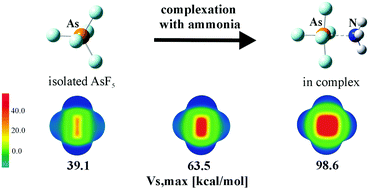Implications of monomer deformation for tetrel and pnicogen bonds†
Abstract
A series of TF4 and ZF5 molecules (T = Si, Ge, Sn and Z = P, As, Sb) were allowed to engage in tetrel and pnicogen bonds, respectively, with NH3, pyrazine, and HCN. The interaction energies are quite large, approaching 50 kcal mol−1 in some cases. The formation of each complex is accompanied by substantial geometrical deformation of the Lewis acid to accommodate the approaching base. The energy associated with this monomer rearrangement is the largest for the smaller central atoms Si and P, where it exceeds 20 kcal mol−1. The total reaction energy of binding, which takes this distortion energy into account, is thus significantly lower than the interaction energy, although remaining quite high, particularly for the larger Sn and Sb central atoms. The tetrel and pnicogen bonds can still form even if the Lewis acid is not permitted to adjust its internal geometry, but they are drastically weakened, dropping by as much as 95%. The monomer rearrangement also aids in the binding by intensifying its σ-hole by a factor of 1.5–2.9.

- This article is part of the themed collection: 1st International Conference on Noncovalent Interactions


 Please wait while we load your content...
Please wait while we load your content...